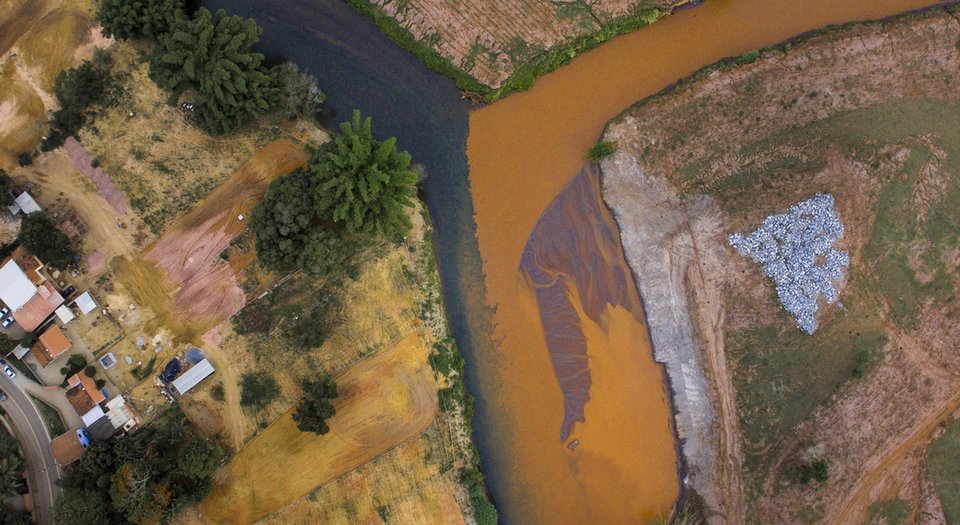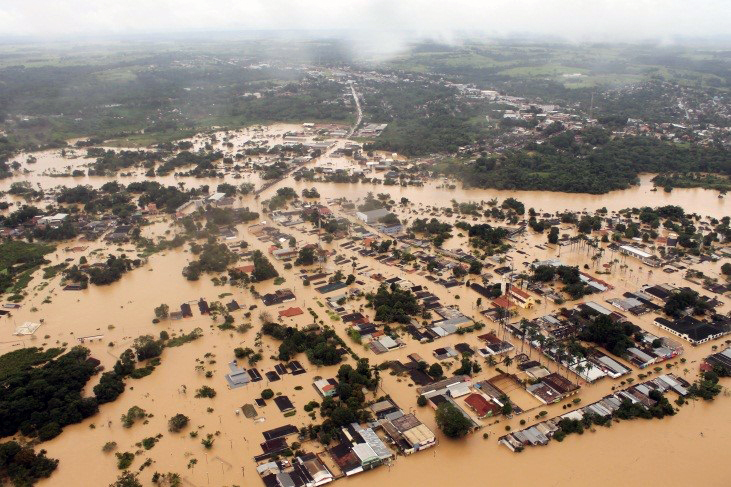Samarco:
Dealing with disasters
Scroll down to read the article
It’s now been more than two and half years since the Fundão tailings dam collapsed in the Brazilian state of Minas Gerais, flooding the Doce River with 60 million cubic metres of toxic sludge. The incident on 5 November 2015 has been described as the worst environmental disaster in Brazilian history, with 19 lives lost as the wave of tailings destroyed the nearby village of Bento Rodrigues on its path towards the southern Atlantic Ocean.
For Samarco, the operator of the Germano iron ore mine and its defective tailings dams, as well as Samarco’s joint venture owners BHP and Vale, those two and a half years have been marked by a dogged and ongoing legal pursuit. A series of lawsuits has plagued the mining giants, with federal prosecutors and civil groups seeking extensive reparations for damages caused, and for what they describe as the companies’ negligent and misleading actions in the run-up to the disaster.
Even as of May this year, new legal challenges are emerging. In this case, it was BHP’s own shareholders holding the company’s feet to the fire. Last month Melbourne-based law firm Phi Finney McDonald announced its intention to launch a class-action lawsuit against BHP on behalf of investors, who, the firm argues, were deceived by the company regarding the condition of the dam. The class action aims to recover shareholder losses incurred between 5 and 30 November 2015 as a result of BHP’s plummeting share price in the wake of the dam breach.
“There are strong grounds to allege that from at least 21 October 2013, BHP failed to ensure that appropriate safety measures were in place at the Fundão dam, including a proper system to warn people living downstream of the dam in the event of a dam failure,” Phi Finney McDonald principal lawyer Brett Spiegel told the Sydney Morning Herald.
For Samarco, a long road to redemption still stretches toward the horizon, with litigation pending, compensation packages still being negotiated, and a plan on the table to eventually resume operations at the Germano mine.
Seeking a settlement
In the immediate aftermath of the Fundão dam collapse in late 2015, Samarco reached a $262m preliminary compensation agreement with state prosecutors, guaranteeing immediate funding for “preventive emergency mitigation, repair or compensation measures”, according to the state prosecution service.
“We know that the amount of damages could be much greater, but the agreement establishes a firm guarantee,” said prosecutor Carlos Eduardo Ferreira Pinto at the time, as quoted by Agence France-Presse.
Indeed, further lawsuits and negotiations over damages became a fixture of the next few years. In March 2016, Samarco and its parent companies reached an agreement to pay around $6bn to settle a lawsuit launched by Brazil’s attorney-general, although the deal was criticised for its financial leniency amid speculation that then-President Dilma Rousseff was seeking a swift resolution to the case to shore up her leadership credentials after the Petrobras corruption scandal.
The settlement, which was broadly unpopular, was hardly the end of Samarco’s legal tribulations, despite BHP and Vale’s hopes that it would draw a line under its financial obligations. In May of the same year, federal prosecutors from the affected states of Minas Gerais and Espírito Santo launched a $44bn civil suit, one of the largest in the country’s history, against the companies. The damages in the suit were calculated against the clean-up costs incurred after the Deepwater Horizon oil spill in the US Gulf of Mexico.
“Preliminary studies show the human, economic and socio-environmental impacts of the collapse of the dam are, at least, equivalent to those verified in the Gulf of Mexico,” the prosecutors argued in a written statement. “It does not seem credible, neither technically nor morally, that the value of the human, cultural and physical environment in Brazil should be worth less than in other countries.”
2017 brought a temporary respite for the companies, as a judge suspended the public lawsuits to allow the partners time to negotiate a final settlement with the government. The negotiation period has been extended several times, most recently in April 2018 for a further 66 days, moving the latest deadline for a framework agreement to 25 June this year. An outline for the negotiations was initially agreed in January 2017 and amended in December that year. Unless negotiations are extended further, the framework agreement announced at this time will set out Samarco’s financial obligations and the framework for payments and works.
Minas Gerais and Espírito Santo launched a $44bn civil suit, one of the largest in the country’s history, against the companies.

The polluted Gualaxo do Norte River flowing into the clean Carmo River. Credit: Gustavo Basso/Shutterstock.
Company executives were unaware of an imminent breach at the dam.
Did Samarco do enough?
The question of whether Samarco and its owners have done enough regarding the disaster splits into two areas – before and after the collapse. The key issue for prosecutors, police investigators and civil groups seeking damages has been the debate over the awareness of Samarco’s leadership that the mine’s dam infrastructure was vulnerable to a catastrophic failure.
Samarco and its parents argue that company executives were unaware of an imminent breach at the dam, which was also used by Vale for its own mine tailings.
“The dam was always declared stable,” Samarco argued, noting that the dam’s size was increased in compliance with the project’s design, and its size was within the limits set by the licence when the disaster occurred.
Federal prosecutors and a police investigation disagreed. A seven-month investigation concluded in June 2016 that Samarco – as well as dam maintenance company VogBR – was guilty of deliberate misconduct in the lead-up to the collapse. The investigation accused Samarco of cutting safety spending in favour of increasing production, ignored clear signs that the dam was at high risk of failure, including cracks discovered by engineers at the eventual site of the breach, and problems regarding the separation of liquid slime tailings and the sand tailings that were intended to keep liquid waste away from the main dam wall.
These organisational failures, Samarco’s accusers argue, meant the dam was primed for a massive failure when a series of small earthquakes set off a chain reaction that kicked off the collapse in November 2015. An independent report by law firm Gottlieb Steen & Hamilton concluded that while an earthquake might have been the immediate catalyst for the disaster, it merely “accelerated the failure process that was already well-advanced”.
The investigation prompted criminal proceedings, including possible murder charges, against the four companies involved and more than 20 executives, including former Samarco chief executive Ricardo Vescovi. A judge suspended the proceedings in August last year after defendants flagged that illicit wiretaps and other data were used to build the police’s case. The case was re-opened in November, with certain evidence excluded and separate trials planned for foreign defendants.
Post-disaster view of the cities of Brasiléia and Epitaciolândia, Acre, Brazil, 2015. Credit: Municipality of Brasiléia.

It is essential to pay wage arrears in full [and] stamp out corruption in the industry
Repairs, remediation and resumption
The evidence presented publicly so far certainly suggests that Samarco and its parent companies could have done much more to prevent the disaster, although criticism has also been levelled at Brazilian regulators at the National Department of Mineral Production, who have been accused of lax oversight regarding the enforcement of dam safety. The result of ongoing civil negotiations and criminal proceedings have yet to emerge, so even more than two years on, it’s still too early to say whether a just outcome will be reached.
Even with pending litigation hanging over the operation, Samarco has been hard at work to begin restoring its image - and those of its owners - compensating affected communities and, eventually, re-starting operations at the mine. The Germano mine was a huge source of employment for the Mariana district, with Samarco reportedly contributing more than $3bn in local investment between 2011 and 2015, and making up more than half of tax revenues in the city of Mariana.
“The city is divided,” Jeffery Fernandes, who was left unemployed after the closure of the mine, told the Guardian newspaper in October 2016. “Many say it was an accident, others that it was Samarco’s fault. Everyone hopes its goes back into production.”
The Renova Foundation was established by Samarco to manage the repair and compensation of local communities, and in May this year it began construction work on a new village in nearby Lavoura for displaced residents of Bento Rodrigues, in close collaboration with the community, which approved the settlement’s urban design in February. The coming months will see the completion of offices, a medical centre and workshops, while community members will be able to discuss their requirements for residential buildings directly with planners.
In December last year Samarco received environmental licences to resume operation at the mine, with the Alegria Sul pit acting as a new tailings facility. A new monitoring and inspection centre has been implemented by Samarco based on the lessons learned from the Fundão collapse, and the company’s new interim CEO Rodrigo Vilela is determined to get the mine complex running again.
“My main objective is to make Samarco operate again, with maximum safety,” Vilela said in March, when his appointment as chief executive was announced. Vale executives said in February that the partners expect to resume operations at the end of this year or in early 2019.
The Germano mine complex obviously plays a much-missed economic role in the surrounding communities, and it seems a resumption of operations would be enthusiastically received by many local people. But Samarco, BHP and Vale, as well as federal prosecutors and state regulators, have the responsibility to ensure that a repeat of the Bento Rodrigues disaster is not a possibility. Reaching a final settlement on compensation will be important to bring resolution for those affected by the tragedy, and the project partners will need to employ all the lessons learned from the organisational fiasco that led to it.
“The constant and disciplined practice of integrity is no easy task,” wrote Samarco compliance and risk manager Roberta Porto in a March blog post. “In the case of Samarco, in particular, I am convinced that this path is fundamental for regaining the bonds of trust with the many types of public that we interact with.”
My main objective is to make Samarco operate again, with maximum safety," Vilela said in March, when his appointment as chief executive was announced.